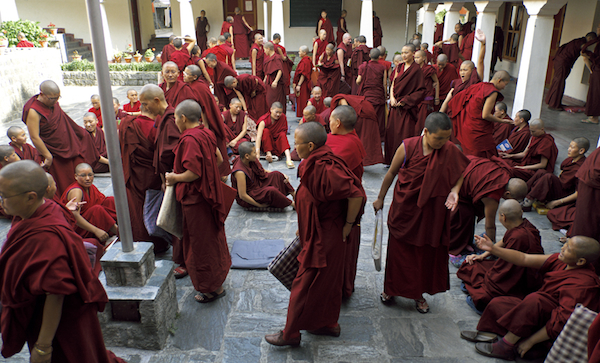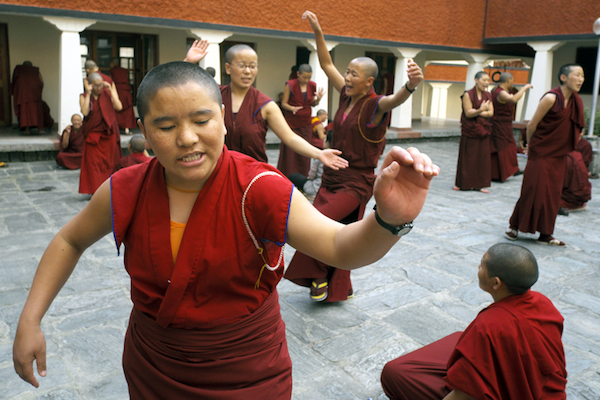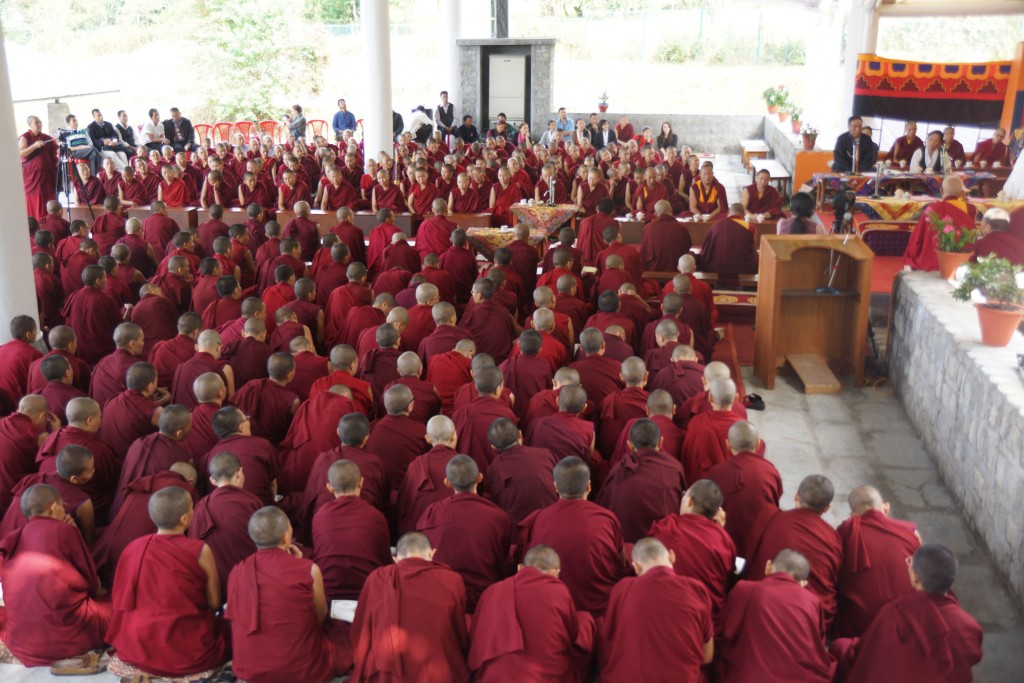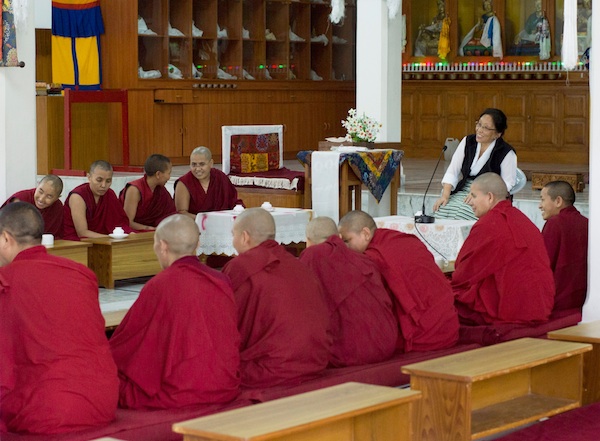“Last year the Jang Gonchoe was an excellent one. We debated till midnight each day. We were overjoyed to share our ideas and thoughts. There were about 400 nuns and all were full with enthusiasm and eager to debate with one another.”
Tenzin Nyidon, Dolma Ling Nunnery and Institute
For centuries, Tibetan monks have held an annual month-long debating session called Jang Gonchoe. The event was so named for Jang, the region in Tibet west of Lhasa where the month long inter-monastery debate originated, and Gonchoe, which is Tibetan for winter debate.

The nuns of Dolma Ling Nunnery and Institute practicing debate in 2013 prior to the completion of the new debate courtyard. Photo courtesy of Brian Harris.
The practice of debate takes many years to fully master and is critical to fostering the nuns’ ability to assume roles as fully qualified teachers of their tradition. In 2015, it will be 20 years since the nuns started taking part in the Jang Gonchoe and building their own strong tradition of debate. Thanks to the generosity of our supporters, the Tibetan Nuns Project has so far been able to support the Jang Gonchoe for 17 years through major gifts and $100 scholarships to the nuns.
It is our wish to create an endowment for the Jang Gonchoe so it may continue for years to come. The amount needed for full endowment at current exchange and interest rates in India is $300,000.
We have received an initial gift of $35,000 from a nun living in France. By donating to the endowment you are not only helping to preserve the Tibetan culture, but you are opening up a centuries-old tradition to the nuns and enabling and empowering them to become great teachers in their own right. The benefit of this is inestimable and will be an enduring legacy for generations to come.
This is a unique opportunity to build capacity and equality for the nuns, to help ensure that a centuries-old tradition continues and expands to include the nuns, and to foster the dharma for future generations.

Nuns of Dolma Ling Nunnery and Institute debating in the spring of 2013. Photo courtesy of Brian Harris
Background on the Jang Gonchoe Debates
The practice of debate combines logical thinking with a deeper understanding of Buddhist philosophy and is an essential part of monastic education in the Tibetan tradition.
Until the 1990s, Tibetan Buddhist nuns we excluded from this form and level of education and the Tibetan Nuns Project has worked hard to open up this opportunity for the nuns and make debate a core part of their education. Establishing a comparable debate session for nuns has been an integral part of the nuns reaching the level of excellence in their studies that they have.
On September 20, 1995, an historic event took place in the development of the nuns. The first inter-nunnery debate, modeled on the Jang Gonchoe debate of the great monastic institutions of Tibet, was held in Dharamsala. It was organized by the Department of Religion and Culture and was attended by nuns from 4 nunneries in India–Jangchup Choeling, Jamyang Choeling, Geden Choeling, and Dolma Ling.
For the first time in the history of Tibet, nuns debated in front of His Holiness the Dalai Lama for almost two hours. His Holiness was very happy to see their debate because for many years He had been asking nuns to study the higher topics of Buddhism.
Venerable Jampa Tsedroen from Germany donated funding for the first year, but during the second year, 1996, there was no specific funding so the participating nunneries from Dharamsala could only afford half a month debate session while Jangchup Choeling nuns from South India were unable to attend the session altogether.
In the third year, 1997, the nunneries approached the Tibetan Nuns Project for assistance. The Tibetan Nuns Project felt strongly that this method of learning which helped to produce many famous scholars in the monasteries over many centuries must continue and be open to the nuns and so agreed to accept the responsibility for raising the necessary support each year. The Jang Gonchoe session is a great opportunity for the nuns in sharping their mind and sharing their knowledge and debating skill among themselves.
The Growth of the Nuns’ Jang Gonchoe
The number of nuns wanting to participate in the Jang Gonchoe is increasing steadily. At the Jang Gonchoe at Dolma Ling Nunnery & Institute in 2013, over 400 nuns from 8 nunneries in India and Nepal took part in the event.
An average of 7 nunneries take part each year. All nunneries are welcome to join when they can. The main obstacle to wider participation is funding – for travel, food and accommodation for nuns to attend.
• Dolma Ling Nunnery & Institute – participant since 1995
• Jangchup Choeling Nunnery – participant since 1995
• Jamyang Choeling Nunnery – participant since 1995
• Geden Choeling Nunnery – participant since 1995
• Khacho Ghakil Ling, Nepal – yearly participant
• Thugjee Choeling Nunnery, Nepal – yearly participant
• The Buddhist Education Centre from Kinnaur – yearly participant
• Drikung Nunnery – participant once
• Dongyu Gyatseling Nunnery – occasional participant
• Sherab Choeling Nunnery, Spiti – occasional participant
• Yangchen Choeling Nunnery, Spiti – occasional participant
• Jampa Choeling Nunnery, Spiti – occasional participant
• (The nuns from the latter three nunneries now hold their own inter-nunnery debate session each year in Spiti.)
Under guidance from the Tibetan Nuns Project, the nuns themselves have taken on the organizing role. Since 2011, a nuns’ committee formed with two representatives from each participating nunnery has taken responsibility for making all the plans and arrangements for the session.
The venue of the Jang Gonchoe site is rotated among the participating nunneries. It costs more when the debate session is held in Nepal or in South India because most of the nunneries are situated in North India. The annual cost of the Jang Gonchoe varies from between $13,000 and $20,000 depending on the location, the number of nuns participating, and the year. Rapid inflation in India over the past few years has put great pressure on the nunneries, especially for things like food and fuel costs.
The Tibetan Nuns Project fundraises for $100 scholarships to enable nuns to take part. Each year, the Tibetan Nuns Project ensures that at least 25 nuns and two Buddhist philosophy teachers from each participating nunnery are sponsored to attend. As the number of nuns wanting to participate in the session is increasing steadily, when more than 25 from a particular nunnery wish to attend they have to find the funding individually or through their nunnery. The total number of extra nuns that can attend depends on the availability of accommodation in the host nunnery.
“I would like to thank you so much for supporting our education. It is all because of your support that I’m getting all these opportunities to study dharma in Dolma Ling. It has been 10 years now since I’m studying here. It is only through debate and discussion with teachers and dharma friends that has helped me to improve my knowledge and understanding of the teaching in a much better way.”
Tenzin Chonyi, Dolma Ling Nunnery and Institute
To donate to the Endowment for the Jang Gonchoe debates, please visit our online donation page or send a check to:
The Tibetan Nuns Project
815 Seattle Boulevard South #216
Seattle, WA 98134 USA
Phone: (206) 652-8901
info@tnp.org

















